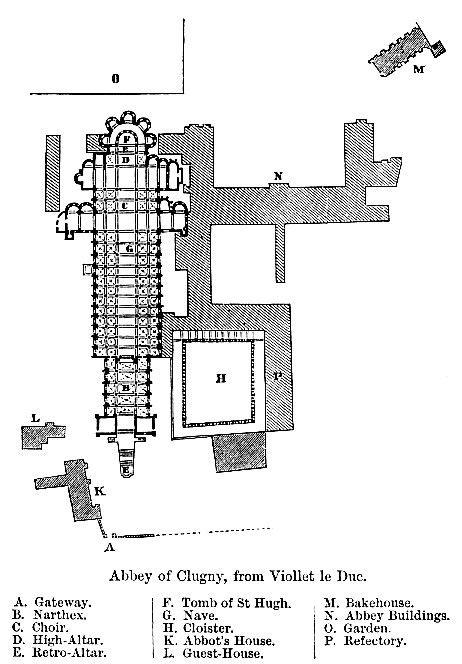1902 Encyclopedia > Abbey > Cluniac Abbeys: Cluny Abbey [Abbey of Clugny], France. English Cluniac Houses.
Abbey
(Part 9)
(C) Cluniac Abbeys
Cluny Abbey [Abbey of Clugny], France
The history of Monasticism is one of alternate periods of decay and revival. With growth in popular esteem came increase in material wealth, leading to luxury and worldliness. The first religious ardour cooled, the strictness of the rule was relaxed, until by the 10th century the decay of discipline was so complete in France that the monks are said to have frequently unacquainted with the rule of St Benedict, and even ignorant that they were bound by any rule at all. (Robertson's Church History, ii p. 538). These alternations are reflected in the monastic buildings and the arrangement of the establishment.
The reformation of these prevalent abuses generally took the form of the establishment of new monastic orders, with new and more stringent rules, requiring a modification of the architectural arrangements.

Cluny Abbey, from Viollet le Duc
One of the earliest of these reformed orders was the Cluniac. This order took its name from the little village of Clugny [Cluny], 12 miles N.W. of Macon, near which, about A.D. 909, a reformed Benedictine abbey was founded by William, Duke of Auvergne, under Berno, abbot of Beaume. He was succeeded by Odo, who is often regarded as the founder of the order. The fame of Clugny spread far and wide. Its rigid rule was adopted by a vast number of the old Benedictine abbeys, who placed themselves in affiliation to the mother society, while new foundation sprang up in large numbers, al owing allegiance to the "archabbot," established at Clugny. By the end of the 12th century the number of monasteries affiliated to Clugny in the various countries of Western Europe amounted to 2000. The monastic establishment of Clugny was one of the most extensive and magnificent in France. We may form some idea of its enormous dimensions from the fact recorded, that when, A.D. 1245, Pope Innocent IV., accompanied by twelve cardinals, a patriarch, three archbishops, the two generals of the Carthusians and Cistercians, the king (St Louis), and three of his sons, the queen mother, Baldwin, Count of Flanders and Emperor of Constantinople, the Duke of Burgundy, and six lords, visited the abbey, the whole party, with their attendants, were lodged within the monastery without disarranging the monks, woo in number. Nearly the whole of the abbey buildings, including the magnificent church, were swept away at the close of the last century. When the annexed ground-plan was taken, shortly before its destruction, nearly all the monastery, with the exception of the church, had been rebuilt. The church, the ground-plan of which bears a remarkable resemblance to that of Lincoln Cathedral, was of vast dimensions. It was 656 feet by 130 feet wide. The nave was 102 feet , and the aisles 60 feet high. The nave (G) had double vaulted aisles on either side. Like Lincoln, it had an eastern as well as a western transept, each furnished with apsidal chapels to the east. The western transept was 213 feet long, and the eastern 123 feet. The choir terminated in a semicircular apse (F), surrounded by five chapels, also semicircular. The western entrance was approached by an ante-church, or narthex (B), itself an aisled church of no mean dimensions, flanked by two towers, rising from a stately flight of steps bearing a large stone cross. To the south of the church lay the cloister-court (H), of immense size, placed much further to the west than is usually the case. On the south side of the cloister the refectory(P), an immense building, 100 feet long and 60 feet wide, accommodating six longitudinal and three transverse rows of tables. It was adorned with the portraits of the chief benefactors of the abbey, and with Scriptural subjects. The end wall displayed the Last Judgment. We are unhappily unable to identify any other of the principal buildings (N). The abbot's residence (K), still partly standing, adjoined the entrance-gate. The guest-house (L) was close by. The bakehouse -(M), also remaining, is a detached building if immense size.
English Cluniac Houses
The first English house of the Cluniac order was that of Lewes, founded by the Earl of Warren, cir. A.D. 1077. Of this only a few fragments of the domestic buildings exist. The best preserved Cluniac houses in England and Castle Acre, Norfolk, and Wenlock, in Shropshire. Ground-plans of both are given in Britton's Architectural Antiquities. They show several departures from the Benedictine arrangement. In each the prior's house is remarkably perfect. All Cluniac houses in England were French colonies, governed by priors of that nation. They did not secure their independence nor become "abbeys" till the reign of Henry VI. The Cluniac revival, with all its brilliancy, was but short lived. The celebrity of this, as of other orders, worked its moral ruin. With their growth in wealth and dignity the Cluniac foundations became as worldly in life and as relaxed in discipline as their predecessors, and a fresh reform was needed.
Read the rest of this article:
Abbey - Table of Contents
|
